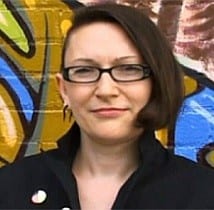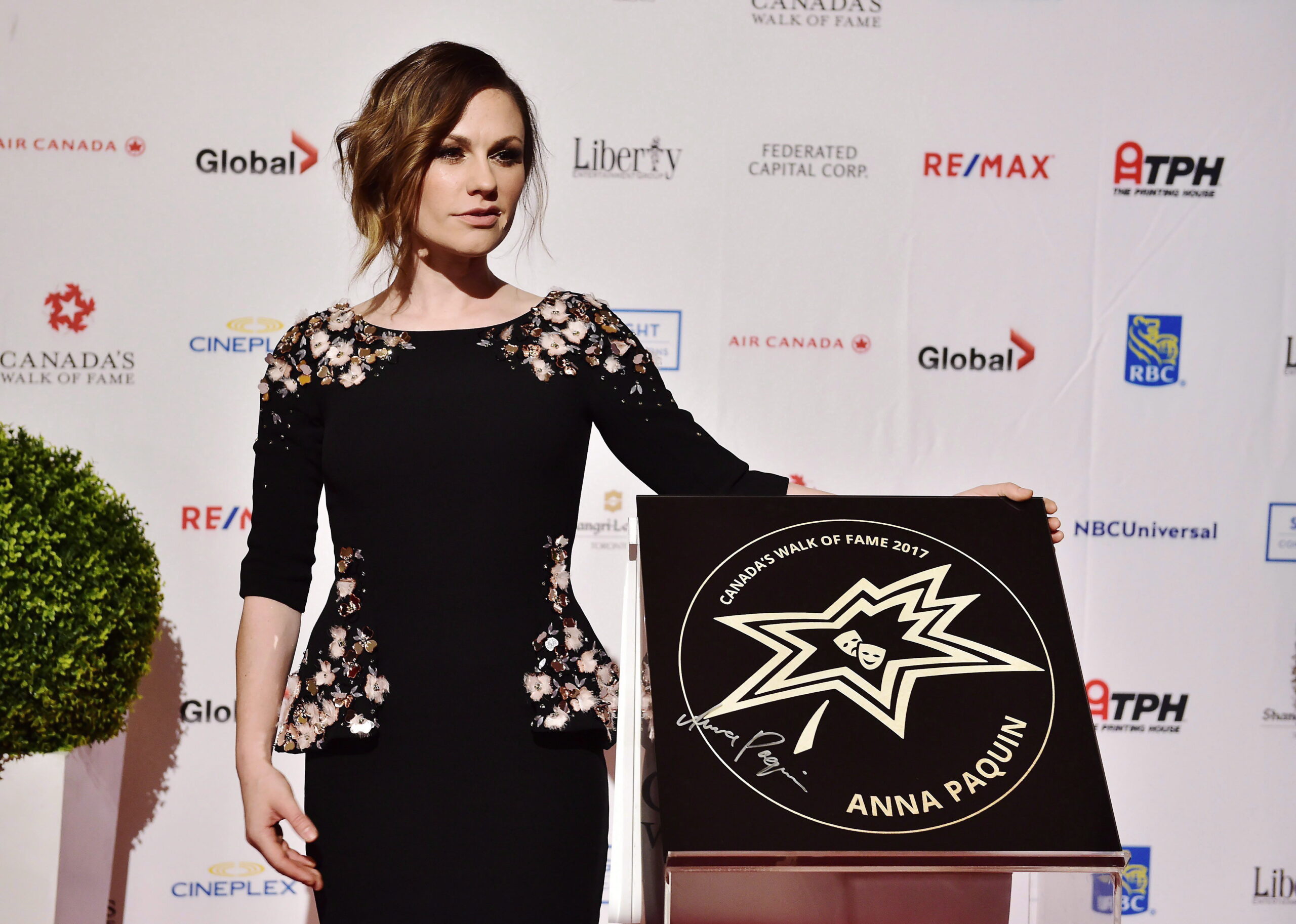From musicians to politicians to figure skaters, we’ve got a range of notable bisexual Canadians as diverse as the spectrum of human sexuality. One thing’s for sure: these are all icons to bring up the next time someone tries to erase how integral bisexual people are to our community and society at-large.
1) Alanis Morissette

Alanis Morissette receives her achievement from the Canadian Music Hall of Fame during the 2015 Juno Awards in Hamilton, Ont, on March 15, 2015. Credit: The Canadian Press/Nathan Denette
Boasting several Juno and Grammy Award wins under her fringed belt, Alanis Morissette was one of the most recognizable voices of the 1990s and started at a young age. This Ottawa-born musician learned piano by the age of six and was writing her own songs by the age of nine, going on to earn a coveted star on Canada’s Walk of Fame.
Morissette has also mentioned past relationships with both men and women, earning her a star in our hearts. The “You Oughta Know” singer-songwriter has leveraged her resources to support causes including gun control, Afghani refugee aid and animal rights. In 2001, she was honoured with a “Global Tolerance Award” by the Friends of the United Nations.
2) Cheri DiNovo

Reverend Cheri DiNovo speaks out against the repeal of Ontario's sex-ed curriculum at a news conference in Toronto on July 13, 2018. Credit: The Canadian Press/Christopher Katsarov
Before she passed more LGBT bills than anyone in Canadian history, Cheri DiNovo lived a turbulent life. After witnessing the death of her father and subsequent suicide of her stepfather, DiNovo dropped out of school in Grade 10 and ran away from home. She lived on the streets for four years, at one point smuggling drugs from California to Canada with hollowed-out Bibles before deciding to finish her high school diploma.
DiNovo was a student at York University in the late 1960s and early 1970s when she made history in 1971 as the only woman to sign Canada’s first gay liberation manifesto. DiNovo went on to become a United Church of Canada minister and a New Democratic Party member at the provincial level before she retired in 2017 and took over the Trinity-St Paul Centre for Faith, Arts and Justice this January.
3) Anna Paquin

Anna Paquin stands next to her star at the Walk of Fame induction ceremony in Toronto on Nov 15, 2017. Credit: The Canadian Press/Frank Gunn
In True Blood, Anna Paquin plays a powerful telepath who stands her own against supernatural creatures, and in real life she has spoken out on several occasions about some of the many misconceptions surrounding bisexuality. In a 2014 HuffPost Live interview, Paquin said, “There’s people that think that monogamy and bisexuality are mutually exclusive.” In support of LGBT equality, the Winnipeg-born actress also tweeted: “marriage is about love not gender.”
The mother-of-two has appeared in numerous films and television shows since her debut performance in the 1993 film The Piano won her the Academy Award for Best Supporting Actress, which made her the second youngest Oscar-winner to date at 11 years old.
4) Sook-Yin Lee

Sook-Yin Lee starred in the 2006 film Shortbus. Credit: The Canadian Press/Everett Collection
Running away from home at the age of 15, living on the street and finding a self-made family among fellow artists sounds like something out of a movie, but it was Sook-Yin Lee’s reality. A celebrated musician, filmmaker, broadcaster and actress today, Lee works predominantly on films which explore feminist and racial issues.
In 2003, John Cameron Mitchell announced that the CBC Radio host would star in his controversial film Shortbus, which portrayed Lee and other cast members performing explicit sexual acts. The CBC urged Lee to turn the role down but relented after its listening audience and several celebrities rallied behind the Vancouver-native. When sexual orientation was held to be protected under the Charter of Rights and Freedoms in 1995, Lee celebrated by kissing a woman on the air and later appeared on the cover of Xtra!
5) Jeromy Farkas

Councillor Jeromy Farkas speaks to reporters in Calgary on Jan 11, 2018. Credit: The Canadian Press/Bill Graveland
Calgary’s first openly LGBT male city councillor, Jeromy Farkas currently serves on the Calgary city council and has pushed the Wildrose Party to take a more progressive stance on LGBT matters. The former columnist for the Calgary Herald is also passionate about issues such as wildlife conservation and human rights activism.
While it is still early in Farkas’ political career, the University of Calgary alumnus’ apparent dedication to transparency with his constituents and bisexual identification has brought him attention on a national scale.
6) Mary MacLane

Mary MacLane (From the inside cover of The Story of Mary MacLane). Credit: Elisa.rolle/Wikimedia Commons;
Mary MacLane is yet another firestarter in Canada’s past. Born in Winnipeg in 1881, she stirred up a great deal of controversy in her lifetime by being openly bisexual and writing exclusively about feminist issues and sexuality in such a raw, confessional tone that her body of work is considered by some to be quite extreme even by today’s standards.
MacLane shocked critics when she wrote openly about her attraction to other women and even of her desire to marry the devil, and is regarded as one of the first writers to employ a more honest, self-aware style of autobiographical writing. She died in Chicago at the age of 48.
7) Tanya Davis

Tanya Davis in the 2014 film Heartbeat. Credit: The Canadian Press/Everett Collection
Not many of us can claim we’ve been this recognized for our way with words. The poet laureate of the Halifax regional municipality from 2011 to 2012, Tanya Davis is a singer-songwriter based in Halifax, Nova Scotia, most well-known for her spoken word poetry performed to music.
Just as she says her sexuality is fluid, the Prince Edward Island native told Xtra in 2009 that she does not strictly identify herself as either a poet or songwriter. Davis has produced three albums since launching her career in 2006. Notably, she hitchhiked from Ottawa to British Columbia after finishing university.
8) Margaret Robinson

Margaret Robinson is a bisexual and two-spirit scholar from Eski'kewaq, Nova Scotia. Credit: Dalhousie University Department of Sociology and Social Anthropology
Did you know that the current director of the Toronto Bisexuality Education Project is an acclaimed Mi’kmaq feminist scholar and activist? Known for her work in the fields of sexuality, Indigenous health and the experiences of mental health by gender and sexual minorities, Margaret Robinson works as an assistant professor at Dalhousie University. In 2016, she led the creation of The Bisexuality Disclosure Kit in order to measure biphobia faced by bisexual women.
9) Toller Cranston

Legendary Canadian figure skater Toller Cranston. Credit: The Canadian Press/stf
Recognized as one of the greatest figure skaters of his time, Toller Cranston was both a world and Olympic bronze medalist in figure skating. He was well-known as one of the first to incorporate full body expressions into his routines and don more elaborate costumes, but less commonly known, however, as a painter. Born in Hamilton, Ontario in 1949, Cranston used his talents as an artist to support himself as a young student in Montreal while he pursued his career as a figure skater.
Despite being a six-time national champion, Cranston’s life was riddled with a number of challenges, from being estranged from his family to being diagnosed with a painful knee condition at the age of 13. Although he was told at the time that he would likely never skate again, Cranston defied this diagnosis and continued to skate well into his 60s. He died of a heart attack in 2015.


 Why you can trust Xtra
Why you can trust Xtra


